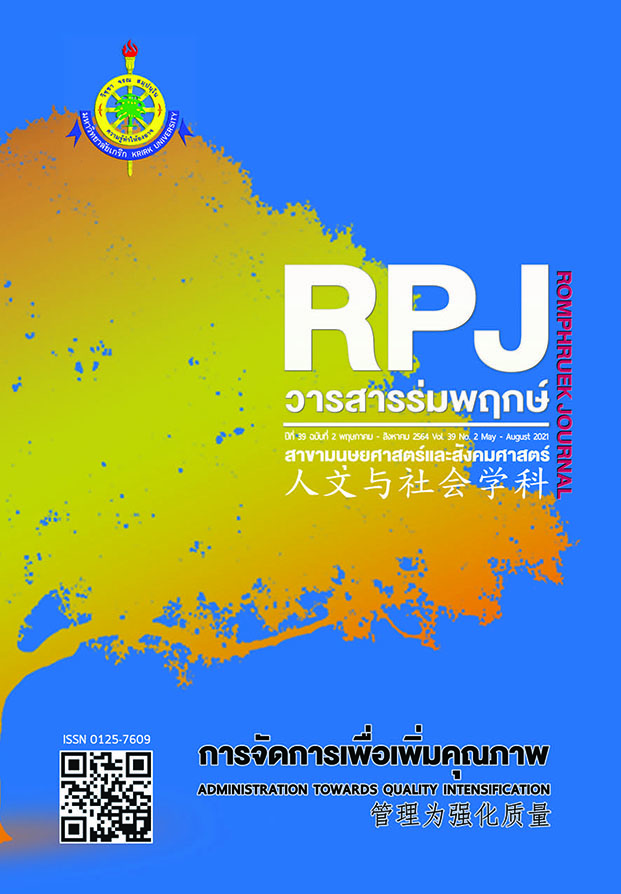A Development and Testing of Health Literacy on Disease Prevention and Control Assessment form for Public Health Officers
Main Article Content
Abstract
This action research aims to develop and to test the health literacy on disease prevention and control assessment of the public health officers. The research was divided into 2 phases: phase 1; including (1) establishing the conceptual framework (2) reviewing the literature and specifying the skills (3) manipulating the structure of the research tool (4) selecting the measuring scale (5) conducting the content validity test. The samples used in this phase were 5 executive experts, purposely selected according to the criteria. The data received from the questionnaire completed by the experts were analyzed. Phase 2; including (1) the trying-out (2) the reliability test (3) the analysis and the classification of health literacy level. The samples used in phase 2 were 98 public health officers, and 5 facilitators. The research tool comprised of a HL questionnaire, a questionnaire of experts’ opinion. The quantitative data were analyzed by using descriptive statistics; frequency, percentage, and mean; Cronbach’s alpha; and qualitative data were analyzed by using content analysis.
The result revealed that the edited edition of the instrument (the new version) was generated based on the empirical references, and the expert reviews with the internal consistency=.81. In the stage of trying out. The assessment form was a 20-item questionnaire containing five skills with 5-point scale, 0-4 score: including never, very difficult, difficult, easy, and very easy with the overall reliability =.917, accessibility=.694, understanding=.705, questioning=.797, decision-making =.842, and applying=.852; the test required 10-15 min for self-administering. The cut point was generated based on the result into four groups, following type 3: including 1-inadequate (lower 60%), 2-problematic (60-74.9%), 3-sufficient (75-89.9%), and 4-excellent (upper 90%). These findings showed the development of assessment form and an initial category of the cut point which presented information to fill the gap of each item to improve the skills.
Article Details
Every article published in the Romphruek Journal of the Humanities and Social Sciences is the opinion and point of view of the authors. Thery're not the viewpoint of Krirk University or the editored department. Any part or all of the articles for pablication must be clearly cited.
References
กรมควบคุมโรค. (2563ก). โครงการพัฒนาศักยภาพบุคลากรกระบวนการเพื่อสร้างความรอบรู้ด้านสุขภาพในการป้องกันโรค. กรุงเทพฯ : สำนักสื่อสารความเสี่ยงและพัฒนาพฤติกรรมสุขภาพ กรมควบคุมโรค กระทรวงสาธารณสุข.
กรมควบคุมโรค. (2563ข). การประเมินความรอบรู้ด้านสุขภาพในการป้องกันควบคุมโรคของประชาชนปี พ.ศ.2563. กรุงเทพฯ : สำนักสื่อสารความเสี่ยงและพัฒนาพฤติกรรมสุขภาพ กรมควบคุมโรค กระทรวงสาธารณสุข.
กรมอนามัย สถาบันวิจัยระบบสาธารณสุข และ มหาวิทยาลัยมหิดล. (2561). รายงานฉบับสมบูรณ์โครง การสำรวจความรอบรู้ด้านสุขภาพในกลุ่มประชาชนอายุ 15 ปีขึ้นไป พ.ศ. 2560 (ระยะที่ 1). (1 พฤศจิกายน 2563) สืบค้นจาก https://www.hsri.or.th/researcher/research/new-release/detail/ 11454.
กองสุขศึกษา. (2561). การสร้างเสริมและประเมินความรู้ด้านสุขภาพและพฤติกรรมสุขภาพ กลุ่มประชาชนอายุ 15 ปีขึ้นไป. กรุงเทพฯ : กรมสนับสนุนบริการสุขภาพ กระทรวงสาธารณสุข.
ขวัญเมือง แก้วดำเกิง. (2562). ความรอบรู้ด้านสุขภาพ : ขั้นพื้นฐาน ปฏิสัมพันธ์ วิจารณญาณ. กรุงเทพฯ : อมรินทร์พริ้นติ้ง แอนด์ พับลิชชิ่ง จำกัด (มหาชน).
ขวัญเมือง แก้วดำเกิง. (2564). ความรอบรู้ด้านสุขภาพ : กระบวนการปฏิบัติการเครื่องมือประเมิน. กรุงเทพฯ : ไอดี ออล ดิจิตอล พริ้นท์.
ประภัสสร วงษ์ดี สำราญ มีแจ้ง รัตนะ บัวสนธ์ และ ปกรณ์ ประจันบาน. (2555). การพัฒนาวิธีการกำหนดจุดตัดเพื่อตัดสินความรอบรู้. วารสารวิทยาการวิจัยและวิทยาการปัญญา, 10(1), 38-55.
สำนักวิชาการและมาตรฐานการศึกษา. (2559). เทคนิค วิธีการจัดกิจกรรมการเรียนรู้ เพื่อขับเคลื่อน จุดเน้นการพัฒนาคุณภาพผู้เรียนด้านทักษะการคิดขั้นพื้นฐาน. กรุงเทพฯ : สำนักงานคณะกรรมการการศึกษาขั้นพื้นฐาน กระทรวงศึกษาธิการ.
Abel, T., Hofmann, K., Ackermann, S., et al. (2015). Health literacy among young adults : a short survey tool for public health and health promotion research. Health Promotion International, 30(3), 725–735.
Chang, L. (2011). Health literacy, self-reported status and health promotion behaviors for adolescents in Taiwan. Journal of Clinical Nursing, 20(16), 190-196.
Duong, VT., Aringazina A., Baisunova, G’, Nurjanah, Pham, V.T., Pham, M.K., et al. (2017). Measuring health literacy in Asia : Validation of the HLS-EU-Q47 survey tool in six Asian countries. Journal of Epidemiology, 27(2), 80-86.
Gibbs, H.D. (2012). Nutrition literacy : Foundations and development of an instrument for assessment. (October 11, 2020) Retrieved from www. ideals.illinois.edu/bitstream/handle/2142/31202/Gibbs_Heather.pdf?sequence=1.
Guo, S., Armstrong, R., Waters, E., Sathish, T., Alif, S.M., Browne G.R. and Yu, X. (2018). Quality of health literacy instruments used in children and adolescents : a systematic review. BMJ Open, 8(6), 1-18.
HLS-EU Consortium. (2015). Comparative Report of Health Literacy in Eight EU Member States. The European Health Literacy Project 2009-2012. (June 17, 2020) Retrieved from http://www. Maastricht -university.nl/.
Ishikawa, H., Takeuchi, T., & Yano, E. (2008a). Measuring functional, communication, and critical health literacy among diabetic patients. Diabetes Care, 31(5), 874-879.
Ishikawa, H., Nomura, K., Sato, M., & Yano, E. (2008b). Developing a measure of communicative and critical health literacy : a pilot study of Japanese office workers. Health Promotion International, 23(3), 269-274.
Levin-Zamir, D. (2012). Health literacy in Israel : Policy, action, research and beyond. (October 11, 2020) Retrieved from https://www.nap.edu/read/18325/chapter/6.
Osborn, C., Weiss, B., Davis, T.C., & Wolf, M. (2007). Measuring adult literacy in health care : performance of the Newest Vital Sign. American Journal of Health Behavior, 31(Supp11), S36-S46.
Quemelo, P.R., Milani, D., Bento, V.F., et al. (2017). Health literacy : translation and validation of a research instrument on health promotion in Brazil. Cad Saude Publica, 33(2), 1-16.
Pelikan, J.M., & Dietscher, C. (2014). Developing health literate health care organizations to better empower patients for co-producing health : from health literacy to health literate health care organizations (HLHCO). (January 21, 2020) Retrieved from http://www.nationalacademies.org/hmd/Reports/2004/.
Pleasant, A. (2012). Health literacy around the world : part 1 health literacy efforts outside of the United States. Institute of Medicine. Tucson, Arizona U.S.A.
Sharif, I. & Blank, A.E. (2010). Relationship between child health literacy and body mass index in overweight children. Patient Education and Counseling, 79(1), 43-48.
Sorensen, K., Broucke, S., Fullam, J., Doyle, G., Pelikan, J, et al. (2012). Health literacy and public health : a systematic review and integration of definitions and models. BMC Public Health, 12(80), 1-13.
Tsai, T., Lee, S.D., & Kuo, Y.N. (2011). Methodology and validation of health literacy scale development in Taiwan. Journal of Health Communication, 16(1), 50 – 61.
Wang, P., Mao, Q., Tao, M., Tian, X., Li, Y., Qian, L. et al. (2010). Survey on the status of health literacy of Chinese residents in 2008. China Journal of Health Education, 26(4), 243–246.
World Health Organization. (2009). Health literacy and health promotion. definitions, concepts and examples in the Eastern Mediterranean Region. (January 7, 2020) Retrieved from http://www.who.int/healthpromotion/conferences/7gchp/Track1_Inner.pdf.


